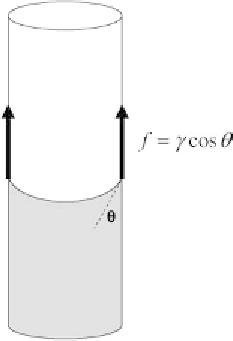Biomedical Engineering Reference
In-Depth Information
When the liquid rises in the tube, the system gains potential energy—because of
the elevation of a volume of liquid—and loses capillary energy—due to the reduc-
tion of the surface energy. The balance is [10]
1
1
2
E
=
ρ
g hV
-
S
I
=
ρ π
g h R h
(
)
-
2
π
RhI
liquid
contact
2
2
(3.40)
1
2 2
=
ρ π
g R h
-
2
π γ θ
Rh
cos
2
Note that the detailed shape of the meniscus has not been taken into account in
(3.40). The interface stabilizes when
∂
E
h
=
0
∂
which results in
2 cos
γ θ
ρ
h
=
(3.41)
g R
Equation (3.41) is the Jurin law. The capillary rise is inversely proportional
to the tube radius. It can be also applied to the case where the liquid level in the
tube decreases below the outer liquid surface; this situation happens when
q
> 90°.
The maximum possible height that a liquid can reach corresponds to
q
= 0:
h
=
2
g
/
ρgR
. In microfluidics, capillary tubes of a 100-
m
m diameter are currently used;
if the liquid is water (
g
= 72 mN/m), and using the approximate value cos
q
~ ½,
the capillary rise is of the order of 14 cm, which is quite important at the scale of a
microcomponent.
What is the capillary force associated to the capillary rise? The capillary force
balances the weight of the liquid in the tube. This weight is given by
2
F
=
ρ π
g R h
Figure 3.32
Sketch of the capillary force of a liquid inside a tube.






